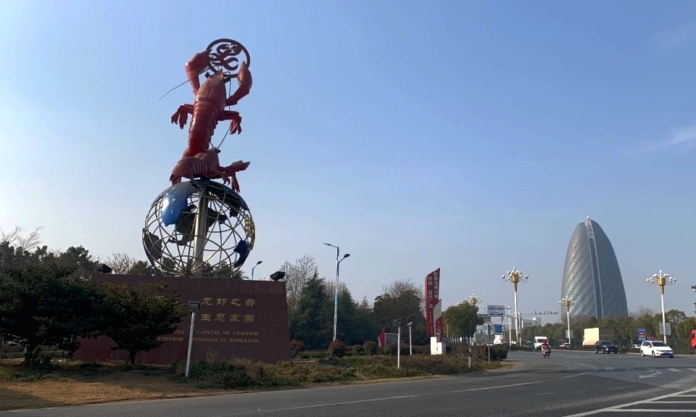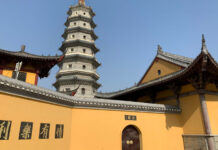China’s appetite for crayfish (longxia; 龙虾) is now well known all over the world. But the side effects of this enormous industry can be surprising, but just as appetising. And one in particular makes a visit to Xuyi worth the trip in itself.
As a county of Huai’an City in Jiangsu, Xuyi has become synonymous with crayfish. An enormous crayfish sculpture sits aside the toll booth that announces your arrival, while the Xuyi government building is a piece of modern architecture based on the shape of a crayfish body.
Yes, there is no escaping crayfish here.
Huai’an is a centre for grain production. Since ancient times, it has been known as “granary of the world” and “hometown of fishing rice”. Located in the alluvial plain of both the Yangtze and Yellow rivers, its crisscrossing rivers and lakes provide for good soil and water quality. With a favourable climate and little pollution, its the perfect spot to grow rice.
And in recent years, rice with a difference. Rice and crayfish grow in identical environments, so local farmers quickly realised they could effectively double their lands’ yields by growing them together. While the crayfish did not seem to mind, the move had quite an effect on the rice.
In fact, the taste and nutritional value of Xuyi’s Crayfish Rice has been highly recognised by experts from the Shanghai Academy of Agricultural Sciences’ Grain Research Institute and the Shanghai Ocean University.
Then in 2017, Xuyi’s Crayfish Rice won a gold award in a national fishing rice competition. And for good reason; not just because of its purple tinge.
While crayfish may not be to everyone’s taste, the rice derived therefrom is just plain delicious.
The Nanjing Crayfish Connection
The crayfish in which so many delight is a close cousin to that famed in Louisiana, USA. Imported to Japan for use as feed for the South American bullfrog, the Japanese so too delighted in the crayfish for being low in fat, high in protein and easy to raise.
With the defeat of Japan in World War II, so the Japanese soldiers, and many civilians, departed Nanjing. Among the many logistical difficulties, what to do with all the crayfish which many Japanese liked to keep as pets?
No right-minded, crayfish-loving Japanese was about to leave their pet to starve. So instead, they plonked them into a lake near Nanjing’s former military airfield (then also the city’s civilian airport) close to Nanjing South Railway Station, where they could feed on both the living and dead organic matter therein.
Here they also multiplied. Fast forward to the 1980s; with living standards improving and people’s diets becoming more varied, so a multitude of crustaceans found their way to the dinner table. As the memory of the Nanjing Massacre was only half a century distant, the crayfish was not one of them.
Yet the Chinese are not about to let anything go to waste, especially economic opportunity, and so it came to be that the enterprising people of Xuyi, in western Jiangsu, saw fit to spend the next few decades turning their city into a crayfish industrial base.
Overall, China is now the world’s biggest exporter of crayfish, while the Chinese themselves chomp their way through more than 90 per cent of global crayfish consumption, over 1 million tons of the beasts each year.
The Nanjinger reminds to not buy dead crayfish, eat them raw or their heads. Can’t finish them? Do ask for a doggy bag, even with no intention of eating them later; unscrupulous restaurants are known to sell leftovers on as new.












